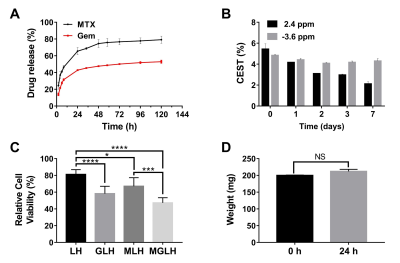Xiongqi Han1, Jianpan Huang1, and Kannie Wai Yan Chan1,2,3
1Biomedical Engineering, City University of Hong Kong, Hong Kong, Hong Kong, 2Biomedical Engineering, Shenzhen Research Institute, City University of Hong Kong, Shenzhen, China, 3Russell H. Morgan Department of Radiology and Radiological Science, The Johns Hopkins University School of Medicine, Baltimore, MD, United States
1Biomedical Engineering, City University of Hong Kong, Hong Kong, Hong Kong, 2Biomedical Engineering, Shenzhen Research Institute, City University of Hong Kong, Shenzhen, China, 3Russell H. Morgan Department of Radiology and Radiological Science, The Johns Hopkins University School of Medicine, Baltimore, MD, United States
We developed a dual chemotherapeutics loaded MGLH hydrogel, which
showed brain compatibility, sequential and sustainable release, combined
cytotoxicity on U87 cells and non-labeling CEST detectability, demonstrating a
promising approach for image-guided local treatment in brain.

Figure 4. Drug release, longitudinally
CEST monitoring, cytotoxicities and swelling of the MGLH (n=3). (A) MTX
and Gem release profiles by UV-vis measurements. (B) the longitudinal CEST tracking of drug release and hydrogel
matrix using contrast at 2.4 ppm (drugs) and -3.6 ppm (hydrogel matrix) on day
0, 1, 2, 3, and 7, respectively. (C) the relative cell viabilities treated with
these hydrogels, using PBS treated group (100%) for normalization. (D)
the swelling tests by gravimetric measurement. P > 0.05, NS; P < 0.05,*; P<0.01,**; P<0.001,***; P<0.0001,****.
